Engage NY Eureka Math 2nd Grade Module 6 Lesson 18 Answer Key
Eureka Math Grade 2 Module 6 Lesson 18 Sprint Answer Key
A. Subtraction from Teens
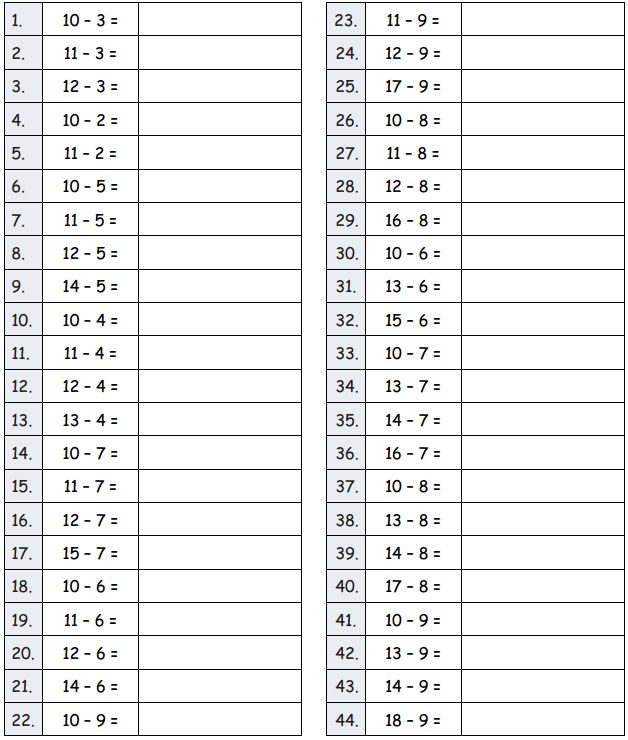

Question 1.
10 – 3 =
Answer:
7
Explanation:
To solve the problem we must put the largest number on top and the smallest number at the bottom 10 – 3. Now we need to subtract the one’s digit. In this case, the subtrahend one’s digit is larger than the minuend one’s digit. Therefore, we need to “borrow” 10 from the minuend ten’s digit which gives you 10 – 3 = 7. Hence the answer is 7.
Question 2.
11 – 3 =
Answer:
8
Explanation:
To solve the problem we must put the largest number on top and the smallest number at the bottom 11 – 3. Now we need to subtract the one’s digit. In this case, the subtrahend one’s digit is larger than the minuend one’s digit. Therefore, we need to “borrow” 10 from the minuend ten’s digit which gives you 10 + 1 – 3 = 8. Hence the answer is 8.
Question 3.
12 – 3 =
Answer:
8
Explanation:
To solve the problem we must put the largest number on top and the smallest number at the bottom 12 – 3. Now we need to subtract the one’s digit. In this case, the subtrahend one’s digit is larger than the minuend one’s digit. Therefore, we need to “borrow” 10 from the minuend ten’s digit which gives you 10 +2 – 3 = 8. Hence the answer is 8.
Question 4.
10 – 2 =
Answer:
8
Explanation:
To solve the problem we must put the largest number on top and the smallest number at the bottom 10 – 2. Now we need to subtract the one’s digit. In this case, the subtrahend one’s digit is larger than the minuend one’s digit. Therefore, we need to “borrow” 10 from the minuend ten’s digit which gives you 10 – 2 = 8. Hence the answer is 8.
Question 5.
11 – 2 =
Answer:
9
Explanation:
To solve the problem we must put the largest number on top and the smallest number at the bottom 11 – 2. Now we need to subtract the one’s digit. In this case, the subtrahend one’s digit is larger than the minuend one’s digit. Therefore, we need to “borrow” 10 from the minuend ten’s digit which gives you 10 + 1 – 7 = 9. Hence the answer is 9.
Question 6.
10 – 5 =
Answer:
5
Explanation:
To solve the problem we must put the largest number on top and the smallest number at the bottom 10 – 5. Now we need to subtract the one’s digit. In this case, the subtrahend one’s digit is larger than the minuend one’s digit. Therefore, we need to “borrow” 10 from the minuend ten’s digit which gives you 10 – 5 = 5. Hence the answer is 5.
Question 7.
11 – 5 =
Answer:
6
Explanation:
To solve the problem we must put the largest number on top and the smallest number at the bottom 11 – 5. Now we need to subtract the one’s digit. In this case, the subtrahend one’s digit is larger than the minuend one’s digit. Therefore, we need to “borrow” 10 from the minuend ten’s digit which gives you 11 + 1 – 5 =6 . Hence the answer is 6.
Question 8.
12 – 5 =
Answer:
7
Explanation:
To solve the problem we must put the largest number on top and the smallest number at the bottom 12 – 5. Now we need to subtract the one’s digit. In this case, the subtrahend one’s digit is larger than the minuend one’s digit. Therefore, we need to “borrow” 10 from the minuend ten’s digit which gives you 10 + 2 – 5 = 7. Hence the answer is 7.
Question 9.
14 – 5 =
Answer:
9
Explanation:
To solve the problem we must put the largest number on top and the smallest number at the bottom 14 – 5. Now we need to subtract the one’s digit. In this case, the subtrahend one’s digit is larger than the minuend one’s digit. Therefore, we need to “borrow” 10 from the minuend ten’s digit which gives you 10 + 4 – 5 = 9. Hence the answer is 9.
Question 10.
10 – 4 =
Answer:
6
Explanation:
To solve the problem we must put the largest number on top and the smallest number at the bottom 10 – 4. Now we need to subtract the one’s digit. In this case, the subtrahend one’s digit is larger than the minuend one’s digit. Therefore, we need to “borrow” 10 from the minuend ten’s digit which gives you 10 – 4 = 6. Hence the answer is 6.
Question 11.
11 – 4 =
Answer:
7
Explanation:
To solve the problem we must put the largest number on top and the smallest number at the bottom 11 – 4. Now we need to subtract the one’s digit. In this case, the subtrahend one’s digit is larger than the minuend one’s digit. Therefore, we need to “borrow” 10 from the minuend ten’s digit which gives you 10 +1 – 4 = 7. Hence the answer is 7.
Question 12.
12 – 4 =
Answer:
8
Explanation:
To solve the problem we must put the largest number on top and the smallest number at the bottom 12 – 4. Now we need to subtract the one’s digit. In this case, the subtrahend one’s digit is larger than the minuend one’s digit. Therefore, we need to “borrow” 10 from the minuend ten’s digit which gives you 10 + 2 – 4 = 8. Hence the answer is 8.
Question 13.
13 – 4 =
Answer:
9
Explanation:
To solve the problem we must put the largest number on top and the smallest number at the bottom 13 – 4. Now we need to subtract the one’s digit. In this case, the subtrahend one’s digit is larger than the minuend one’s digit. Therefore, we need to “borrow” 10 from the minuend ten’s digit which gives you 10 + 3 – 4 = 9. Hence the answer is 9.
Question 14.
10 – 7 =
Answer:
3
Explanation:
To solve the problem we must put the largest number on top and the smallest number at the bottom 10 – 7. Now we need to subtract the one’s digit. In this case, the subtrahend one’s digit is larger than the minuend one’s digit. Therefore, we need to “borrow” 10 from the minuend ten’s digit which gives you 10 – 7 = 3. Hence the answer is 3.
Question 15.
11 – 7 =
Answer:
4
Explanation:
To solve the problem we must put the largest number on top and the smallest number at the bottom 11 – 7. Now we need to subtract the one’s digit. In this case, the subtrahend one’s digit is larger than the minuend one’s digit. Therefore, we need to “borrow” 10 from the minuend ten’s digit which gives you 10 + 1 – 7 = 4. Hence the answer is 4.
Question 16.
12 – 7 =
Answer:
5
Explanation:
To solve the problem we must put the largest number on top and the smallest number at the bottom 12 – 7. Now we need to subtract the one’s digit. In this case, the subtrahend one’s digit is larger than the minuend one’s digit. Therefore, we need to “borrow” 10 from the minuend ten’s digit which gives you 10 + 2 – 7 = 5. Hence the answer is 5.
Question 17.
15 – 7 =
Answer:
8
Explanation:
To solve the problem we must put the largest number on top and the smallest number at the bottom 15 – 7. Now we need to subtract the one’s digit. In this case, the subtrahend one’s digit is larger than the minuend one’s digit. Therefore, we need to “borrow” 10 from the minuend ten’s digit which gives you 10 + 5 – 7 = 8. Hence the answer is 8.
Question 18.
10 – 6 =
Answer:
4
Explanation:
To solve the problem we must put the largest number on top and the smallest number at the bottom 10 – 6. Now we need to subtract the one’s digit. In this case, the subtrahend one’s digit is larger than the minuend one’s digit. Therefore, we need to “borrow” 10 from the minuend ten’s digit which gives you 10 – 6 = 4. Hence the answer is 4.
Question 19.
11 – 6 =
Answer:
5
Explanation:
To solve the problem we must put the largest number on top and the smallest number at the bottom 11 – 6. Now we need to subtract the one’s digit. In this case, the subtrahend one’s digit is larger than the minuend one’s digit. Therefore, we need to “borrow” 10 from the minuend ten’s digit which gives you 10 + 1 – 6 = 5. Hence the answer is 5.
Question 20.
12 – 6 =
Answer:
6
Explanation:
To solve the problem we must put the largest number on top and the smallest number at the bottom 12 – 6. Now we need to subtract the one’s digit. In this case, the subtrahend one’s digit is larger than the minuend one’s digit. Therefore, we need to “borrow” 10 from the minuend ten’s digit which gives you 10 + 2 – 6 = 6. Hence the answer is 6.
Question 21.
14 – 6 =
Answer:
8
Explanation:
To solve the problem we must put the largest number on top and the smallest number at the bottom 14 – 6. Now we need to subtract the one’s digit. In this case, the subtrahend one’s digit is larger than the minuend one’s digit. Therefore, we need to “borrow” 10 from the minuend ten’s digit which gives you 10 + 4 – 6 = 8. Hence the answer is 8.
Question 22.
10 – 9 =
Answer:
1
Explanation:
To solve the problem we must put the largest number on top and the smallest number at the bottom 10 – 9. Now we need to subtract the one’s digit. In this case, the subtrahend one’s digit is larger than the minuend one’s digit. Therefore, we need to “borrow” 10 from the minuend ten’s digit which gives you 10 – 9 = 1. Hence the answer is 1.
Question 23.
11 – 9 =
Answer:
2
Explanation:
To solve the problem we must put the largest number on top and the smallest number at the bottom 11 – 9. Now we need to subtract the one’s digit. In this case, the subtrahend one’s digit is larger than the minuend one’s digit. Therefore, we need to “borrow” 10 from the minuend ten’s digit which gives you 10 + 1 – 9 = 2. Hence the answer is 2.
Question 24.
12 – 9 =
Answer:
3
Explanation:
To solve the problem we must put the largest number on top and the smallest number at the bottom 12 – 9. Now we need to subtract the one’s digit. In this case, the subtrahend one’s digit is larger than the minuend one’s digit. Therefore, we need to “borrow” 10 from the minuend ten’s digit which gives you 10 + 2 – 9 = 3. Hence the answer is 3.
Question 25.
17 – 9 =
Answer:
8
Explanation:
To solve the problem we must put the largest number on top and the smallest number at the bottom 17 – 9. Now we need to subtract the one’s digit. In this case, the subtrahend one’s digit is larger than the minuend one’s digit. Therefore, we need to “borrow” 10 from the minuend ten’s digit which gives you 10 + 7 – 9 = 8. Hence the answer is 8.
Question 26.
10 – 8 =
Answer:
2
Explanation:
To solve the problem we must put the largest number on top and the smallest number at the bottom 10 – 8. Now we need to subtract the one’s digit. In this case, the subtrahend one’s digit is larger than the minuend one’s digit. Therefore, we need to “borrow” 10 from the minuend ten’s digit which gives you 10 – 8 = 2. Hence the answer is 2.
Question 27.
11 – 8 =
Answer:
3
Explanation:
To solve the problem we must put the largest number on top and the smallest number at the bottom 11 – 8. Now we need to subtract the one’s digit. In this case, the subtrahend one’s digit is larger than the minuend one’s digit. Therefore, we need to “borrow” 10 from the minuend ten’s digit which gives you 10 + 1 – 8 = 3. Hence the answer is 3.
Question 28.
12 – 8 =
Answer:
4
Explanation:
To solve the problem we must put the largest number on top and the smallest number at the bottom 12 – 8. Now we need to subtract the one’s digit. In this case, the subtrahend one’s digit is larger than the minuend one’s digit. Therefore, we need to “borrow” 10 from the minuend ten’s digit which gives you 10 + 2 – 8 = 4. Hence the answer is 4.
Question 29.
16 – 8 =
Answer:
8
Explanation:
To solve the problem we must put the largest number on top and the smallest number at the bottom 16 – 8. Now we need to subtract the one’s digit. In this case, the subtrahend one’s digit is larger than the minuend one’s digit. Therefore, we need to “borrow” 10 from the minuend ten’s digit which gives you 10 + 6 – 8 = 8. Hence the answer is 8.
Question 30.
10 – 6 =
Answer:
4
Explanation:
To solve the problem we must put the largest number on top and the smallest number at the bottom 10 – 2. Now we need to subtract the one’s digit. In this case, the subtrahend one’s digit is larger than the minuend one’s digit. Therefore, we need to “borrow” 10 from the minuend ten’s digit which gives you 10 – 6 = 4. Hence the answer is 4.
Question 31.
13 – 6 =
Answer:
7
Explanation:
To solve the problem we must put the largest number on top and the smallest number at the bottom 13 – 6. Now we need to subtract the one’s digit. In this case, the subtrahend one’s digit is larger than the minuend one’s digit. Therefore, we need to “borrow” 10 from the minuend ten’s digit which gives you 10 + 3 – 6 = 7. Hence the answer is 7.
Question 32.
15 – 6 =
Answer:
9
Explanation:
To solve the problem we must put the largest number on top and the smallest number at the bottom 15 – 6. Now we need to subtract the one’s digit. In this case, the subtrahend one’s digit is larger than the minuend one’s digit. Therefore, we need to “borrow” 10 from the minuend ten’s digit which gives you 10 + 5 – 6 = 9. Hence the answer is 9.
Question 33.
10 – 7 =
Answer:
3
Explanation:
To solve the problem we must put the largest number on top and the smallest number at the bottom 10 – 7. Now we need to subtract the one’s digit. In this case, the subtrahend one’s digit is larger than the minuend one’s digit. Therefore, we need to “borrow” 10 from the minuend ten’s digit which gives you 10 – 7 = 3. Hence the answer is 3.
Question 34.
13 – 7 =
Answer:
6
Explanation:
To solve the problem we must put the largest number on top and the smallest number at the bottom 13 – 7. Now we need to subtract the one’s digit. In this case, the subtrahend one’s digit is larger than the minuend one’s digit. Therefore, we need to “borrow” 10 from the minuend ten’s digit which gives you 10 + 3 – 7 = 6. Hence the answer is 6.
Question 35.
14 – 7 =
Answer:
7
Explanation:
To solve the problem we must put the largest number on top and the smallest number at the bottom 14 – 7. Now we need to subtract the one’s digit. In this case, the subtrahend one’s digit is larger than the minuend one’s digit. Therefore, we need to “borrow” 10 from the minuend ten’s digit which gives you 10 + 4 – 7 = 7. Hence the answer is 7.
Question 36.
16 – 7 =
Answer:
9
Explanation:
To solve the problem we must put the largest number on top and the smallest number at the bottom 16 – 7. Now we need to subtract the one’s digit. In this case, the subtrahend one’s digit is larger than the minuend one’s digit. Therefore, we need to “borrow” 10 from the minuend ten’s digit which gives you 10 + 6 – 7 = 9. Hence the answer is 9.
Question 37.
10 – 8 =
Answer:
2
Explanation:
To solve the problem we must put the largest number on top and the smallest number at the bottom 10 – 8. Now we need to subtract the one’s digit. In this case, the subtrahend one’s digit is larger than the minuend one’s digit. Therefore, we need to “borrow” 10 from the minuend ten’s digit which gives you 10 – 9 = 2. Hence the answer is 2.
Question 38.
13 – 8 =
Answer:
5
Explanation:
To solve the problem we must put the largest number on top and the smallest number at the bottom 13 – 8. Now we need to subtract the one’s digit. In this case, the subtrahend one’s digit is larger than the minuend one’s digit. Therefore, we need to “borrow” 10 from the minuend ten’s digit which gives you 10 + 3 – 8 = 5. Hence the answer is 5.
Question 39.
14 – 8 =
Answer:
6
Explanation:
To solve the problem we must put the largest number on top and the smallest number at the bottom 14 – 8. Now we need to subtract the one’s digit. In this case, the subtrahend one’s digit is larger than the minuend one’s digit. Therefore, we need to “borrow” 10 from the minuend ten’s digit which gives you 10 + 4 – 8 = 6. Hence the answer is 6.
Question 40.
17 – 8 =
Answer:
9
Explanation:
To solve the problem we must put the largest number on top and the smallest number at the bottom 17 – 8. Now we need to subtract the one’s digit. In this case, the subtrahend one’s digit is larger than the minuend one’s digit. Therefore, we need to “borrow” 10 from the minuend ten’s digit which gives you 10 + 7 – 8 = 9. Hence the answer is 9.
Question 41.
10 – 9 =
Answer:
1
Explanation:
To solve the problem we must put the largest number on top and the smallest number at the bottom 10 – 9. Now we need to subtract the one’s digit. In this case, the subtrahend one’s digit is larger than the minuend one’s digit. Therefore, we need to “borrow” 10 from the minuend ten’s digit which gives you 10 – 9 = 1. Hence the answer is 1.
Question 42.
13 – 9 =
Answer:
4
Explanation:
To solve the problem we must put the largest number on top and the smallest number at the bottom 13 – 9. Now we need to subtract the one’s digit. In this case, the subtrahend one’s digit is larger than the minuend one’s digit. Therefore, we need to “borrow” 10 from the minuend ten’s digit which gives you 10 + 3 – 9 = 4. Hence the answer is 4.
Question 43.
14 – 9 =
Answer:
5
Explanation:
To solve the problem we must put the largest number on top and the smallest number at the bottom 14 – 9. Now we need to subtract the one’s digit. In this case, the subtrahend one’s digit is larger than the minuend one’s digit. Therefore, we need to “borrow” 10 from the minuend ten’s digit which gives you 10 + 4 – 9 = 5. Hence the answer is 5.
Question 44.
18 – 9 =
Answer:
9
Explanation:
To solve the problem we must put the largest number on top and the smallest number at the bottom 18 – 9. Now we need to subtract the one’s digit. In this case, the subtrahend one’s digit is larger than the minuend one’s digit. Therefore, we need to “borrow” 10 from the minuend ten’s digit which gives you 10 +8 – 9 = 9. Hence the answer is 9.
B. Subtraction from Teens
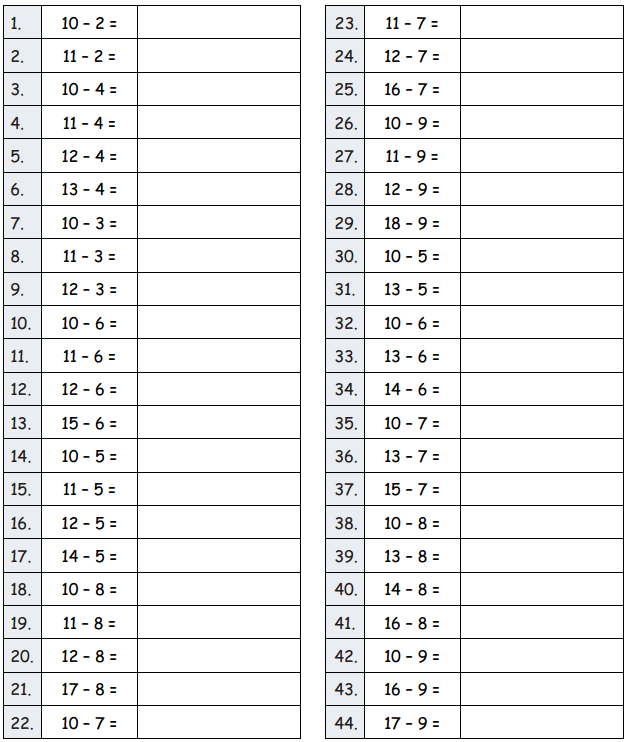

Question 1.
10 – 2 =
Answer:
8
Explanation:
To solve the problem we must put the largest number on top and the smallest number at the bottom 10 – 2. Now we need to subtract the one’s digit. In this case, the subtrahend one’s digit is larger than the minuend one’s digit. Therefore, we need to “borrow” 10 from the minuend ten’s digit, giving you 10 – 2 = 8. Hence the answer is 8.
Question 2.
11 – 2 =
Answer:
9
Explanation:
To solve the problem we must put the largest number on top and the smallest number at the bottom 11 – 2. Now we need to subtract the one’s digit. In this case, the subtrahend one’s digit is larger than the minuend one’s digit. Therefore, we need to “borrow” 10 from the minuend ten’s digit, giving you 10 + 1 – 2 = 9. Hence the answer is 9.
Question 3.
10 – 4 =
Answer:
6
Explanation:
To solve the problem we must put the largest number on top and the smallest number at the bottom 10 – 4. Now we need to subtract the one’s digit. In this case, the subtrahend one’s digit is larger than the minuend one’s digit. Therefore, we need to “borrow” 10 from the minuend ten’s digit giving you 10 – 4= 6. Hence the answer is 6.
Question 4.
11 – 4 =
Answer:
7
Explanation:
To solve the problem we must put the largest number on top and the smallest number at the bottom 11 – 4. Now we need to subtract the one’s digit. In this case, the subtrahend one’s digit is larger than the minuend one’s digit. Therefore, we need to “borrow” 10 from the minuend ten’s digit giving you 10 + 1 – 4 = 7. Hence the answer is 7.
Question 5.
12 – 4 =
Answer:
8
Explanation:
To solve the problem we must put the largest number on top and the smallest number at the bottom 12 – 4. Now we need to subtract the one’s digit. In this case, the subtrahend one’s digit is larger than the minuend one’s digit. Therefore, we need to “borrow” 10 from the minuend ten’s digit giving you 10 + 2 – 4 = 8. Hence the answer is 8.
Question 6.
13 – 4 =
Answer:
9
Explanation:
To solve the problem we must put the largest number on top and the smallest number at the bottom 13 – 4. Now we need to subtract the one’s digit. In this case, the subtrahend one’s digit is larger than the minuend one’s digit. Therefore, we need to “borrow” 10 from the minuend ten’s digit giving you 10 + 3 – 4 = 9. Hence the answer is 9.
Question 7.
10 – 3 =
Answer:
7
Explanation:
To solve the problem we must put the largest number on top and the smallest number at the bottom 10 – 3. Now we need to subtract the one’s digit. In this case, the subtrahend one’s digit is larger than the minuend one’s digit. Therefore, we need to “borrow” 10 from the minuend ten’s digit giving you 10 – 3= 7. Hence the answer is 7.
Question 8.
11 – 3 =
Answer:
8
Explanation:
To solve the problem we must put the largest number on top and the smallest number at the bottom 11 – 3. Now we need to subtract the one’s digit. In this case, the subtrahend one’s digit is larger than the minuend one’s digit. Therefore, we need to “borrow” 10 from the minuend ten’s digit giving you 10 + 1 – 3 = 8. Hence the answer is 8.
Question 9.
12 – 3 =
Answer:
9
Explanation:
To solve the problem we must put the largest number on top and the smallest number at the bottom 12 – 3. Now we need to subtract the one’s digit. In this case, the subtrahend one’s digit is larger than the minuend one’s digit. Therefore, we need to “borrow” 10 from the minuend ten’s digit giving you 10 + 2 – 3 = 9. Hence the answer is 9.
Question 10.
10 – 6 =
Answer:
4
Explanation:
To solve the problem we must put the largest number on top and the smallest number at the bottom 10 – 6. Now we need to subtract the one’s digit. In this case, the subtrahend one’s digit is larger than the minuend one’s digit. Therefore, we need to “borrow” 10 from the minuend ten’s digit giving you 10- 6 = 4. Hence the answer is 4.
Question 11.
11 – 6 =
Answer:
5
Explanation:
To solve the problem we must put the largest number on top and the smallest number at the bottom 11 – 6. Now we need to subtract the one’s digit. In this case, the subtrahend one’s digit is larger than the minuend one’s digit. Therefore, we need to “borrow” 10 from the minuend ten’s digit giving you 10 + 1 – 6 = 4. Hence the answer is 4.
Question 12.
12 – 6 =
Answer:
6
Explanation:
To solve the problem we must put the largest number on top and the smallest number at the bottom 12 – 6. Now we need to subtract the one’s digit. In this case, the subtrahend one’s digit is larger than the minuend one’s digit. Therefore, we need to “borrow” 10 from the minuend ten’s digit giving you 10 + 2 – 6 = 6. Hence the answer is 6.
Question 13.
15 – 6 =
Answer:
9
Explanation:
To solve the problem we must put the largest number on top and the smallest number at the bottom 15 – 6. Now we need to subtract the one’s digit. In this case, the subtrahend one’s digit is larger than the minuend one’s digit. Therefore, we need to “borrow” 10 from the minuend ten’s digit giving you 10 +5 – 6 = 9. Hence the answer is 9.
Question 14.
10 – 5 =
Answer:
5
Explanation:
To solve the problem we must put the largest number on top and the smallest number at the bottom 10 – 5. Now we need to subtract the one’s digit. In this case, the subtrahend one’s digit is larger than the minuend one’s digit. Therefore, we need to “borrow” 10 from the minuend ten’s digit giving you 10 – 5 = 5. Hence the answer is 5.
Question 15.
11 – 5 =
Answer:
6
Explanation:
To solve the problem we must put the largest number on top and the smallest number at the bottom 11 – 5. Now we need to subtract the one’s digit. In this case, the subtrahend one’s digit is larger than the minuend one’s digit. Therefore, we need to “borrow” 10 from the minuend ten’s digit giving you 10 + 1 – 5 = 6. Hence the answer is 6.
Question 16.
12 – 5 =
Answer:
7
Explanation:
To solve the problem we must put the largest number on top and the smallest number at the bottom 12 – 5. Now we need to subtract the one’s digit. In this case, the subtrahend one’s digit is larger than the minuend one’s digit. Therefore, we need to “borrow” 10 from the minuend ten’s digit giving you 10 + 2 – 5 = 7. Hence the answer is 7.
Question 17.
14 – 5 =
Answer:
9
Explanation:
To solve the problem we must put the largest number on top and the smallest number at the bottom 14 – 5. Now we need to subtract the one’s digit. In this case, the subtrahend one’s digit is larger than the minuend one’s digit. Therefore, we need to “borrow” 10 from the minuend ten’s digit giving you 10 + 4 – 5 = 9. Hence the answer is 9.
Question 18.
10 – 8 =
Answer:
2
Explanation:
To solve the problem we must put the largest number on top and the smallest number at the bottom 10 – 8. Now we need to subtract the one’s digit. In this case, the subtrahend one’s digit is larger than the minuend one’s digit. Therefore, we need to “borrow” 10 from the minuend ten’s digit which gives you 10 – 8 = 2. Hence the answer is 2.
Question 19.
11 – 8 =
Answer:
2
Explanation:
To solve the problem we must put the largest number on top and the smallest number at the bottom 11 – 8. Now we need to subtract the one’s digit. In this case, the subtrahend one’s digit is larger than the minuend one’s digit. Therefore, we need to “borrow” 10 from the minuend ten’s digit giving you 10 + 1 – 8 = 2. Hence the answer is 2.
Question 20.
12 – 8 =
Answer:
4
Explanation:
To solve the problem we must put the largest number on top and the smallest number at the bottom 12 – 8. Now we need to subtract the one’s digit. In this case, the subtrahend one’s digit is larger than the minuend one’s digit. Therefore, we need to “borrow” 10 from the minuend ten’s digit giving you 10 + 2 – 8 = 4. Hence the answer is 4.
Question 21.
17 – 8 =
Answer:
9
Explanation:
To solve the problem we must put the largest number on top and the smallest number at the bottom 17 – 8. Now we need to subtract the one’s digit. In this case, the subtrahend one’s digit is larger than the minuend one’s digit. Therefore, we need to “borrow” 10 from the minuend ten’s digit giving you 10 + 7 – 8 = 9. Hence the answer is 9.
Question 22.
10 – 7 =
Answer:
3
Explanation:
To solve the problem we must put the largest number on top and the smallest number at the bottom 10 – 7. Now we need to subtract the one’s digit. In this case, the subtrahend one’s digit is larger than the minuend one’s digit. Therefore, we need to “borrow” 10 from the minuend ten’s digit gives you 10 – 7 = 3. Hence the answer is 3.
Question 23.
11 – 7 =
Answer:
4
Explanation:
To solve the problem we must put the largest number on top and the smallest number at the bottom 11 – 7. Now we need to subtract the one’s digit. In this case, the subtrahend one’s digit is larger than the minuend one’s digit. Therefore, we need to “borrow” 10 from the minuend ten’s digit which gives you 10 + 1 – 7 = 4. Hence the answer is 4.
Question 24.
12 – 7 =
Answer:
5
Explanation:
To solve the problem we must put the largest number on top and the smallest number at the bottom 12 – 7. Now we need to subtract the one’s digit. In this case, the subtrahend one’s digit is larger than the minuend one’s digit. Therefore, we need to “borrow” 10 from the minuend ten’s digit which gives you 10 + 2 – 7 = 5. Hence the answer is 5.
Question 25.
16 – 7 =
Answer:
9
Explanation:
To solve the problem we must put the largest number on top and the smallest number at the bottom 16 – 7. Now we need to subtract the one’s digit. In this case, the subtrahend one’s digit is larger than the minuend one’s digit. Therefore, we need to “borrow” 10 from the minuend ten’s digit which gives you 10 + 6 – 7 = 9. Hence the answer is 9.
Question 26.
10 – 9 =
Answer:
1
Explanation:
To solve the problem we must put the largest number on top and the smallest number at the bottom 10 – 9. Now we need to subtract the one’s digit. In this case, the subtrahend one’s digit is larger than the minuend one’s digit. Therefore, we need to “borrow” 10 from the minuend ten’s digit which gives you 10 – 9 = 1. Hence the answer is 1.
Question 27.
11 – 9 =
Answer:
2
Explanation:
To solve the problem we must put the largest number on top and the smallest number at the bottom 11 – 9. Now we need to subtract the one’s digit. In this case, the subtrahend one’s digit is larger than the minuend one’s digit. Therefore, we need to “borrow” 10 from the minuend ten’s digit which gives you 10 + 1 – 9 = 2. Hence the answer is 2.
Question 28.
12 – 9 =
Answer:
3
Explanation:
To solve the problem we must put the largest number on top and the smallest number at the bottom 12 – 9. Now we need to subtract the one’s digit. In this case, the subtrahend one’s digit is larger than the minuend one’s digit. Therefore, we need to “borrow” 10 from the minuend ten’s digit which gives you 10 + 2 – 9 = 3. Hence the answer is 3.
Question 29.
18 – 9 =
Answer:
9
Explanation:
To solve the problem we must put the largest number on top and the smallest number at the bottom 18 – 9. Now we need to subtract the one’s digit. In this case, the subtrahend one’s digit is larger than the minuend one’s digit. Therefore, we need to “borrow” 10 from the minuend ten’s digit which gives you 10 + 8 – 9 = 9. Hence the answer is 9.
Question 30.
10 – 5 =
Answer:
5
Explanation:
To solve the problem we must put the largest number on top and the smallest number at the bottom 10 – 5. Now we need to subtract the one’s digit. In this case, the subtrahend one’s digit is larger than the minuend one’s digit. Therefore, we need to “borrow” 10 from the minuend ten’s digit which gives you 10 – 5 = 5. Hence the answer is 5.
Question 31.
13 – 5 =
Answer:
8
Explanation:
To solve the problem we must put the largest number on top and the smallest number at the bottom 13 – 5. Now we need to subtract the one’s digit. In this case, the subtrahend one’s digit is larger than the minuend one’s digit. Therefore, we need to “borrow” 10 from the minuend ten’s digit which gives you 10 + 3 – 5 = 8. Hence the answer is 8.
Question 32.
10 – 6 =
Answer:
4
Explanation:
To solve the problem we must put the largest number on top and the smallest number at the bottom 10 – 6. Now we need to subtract the one’s digit. In this case, the subtrahend one’s digit is larger than the minuend one’s digit. Therefore, we need to “borrow” 10 from the minuend ten’s digit which gives you 10 – 6 = 4. Hence the answer is 4.
Question 33.
13 – 6 =
Answer:
7
Explanation:
To solve the problem we must put the largest number on top and the smallest number at the bottom 13 – 6. Now we need to subtract the one’s digit. In this case, the subtrahend one’s digit is larger than the minuend one’s digit. Therefore, we need to “borrow” 10 from the minuend ten’s digit which gives you 10 + 3 – 6 = 7. Hence the answer is 7.
Question 34.
14 – 6 =
Answer:
8
Explanation:
To solve the problem we must put the largest number on top and the smallest number at the bottom 14 – 8. Now we need to subtract the one’s digit. In this case, the subtrahend one’s digit is larger than the minuend one’s digit. Therefore, we need to “borrow” 10 from the minuend ten’s digit which gives you 10 + 4 – 6 = 8. Hence the answer is 8.
Question 35.
10 – 7 =
Answer:
3
Explanation:
To solve the problem we must put the largest number on top and the smallest number at the bottom 10 – 7. Now we need to subtract the one’s digit. In this case, the subtrahend one’s digit is larger than the minuend one’s digit. Therefore, we need to “borrow” 10 from the minuend ten’s digit which gives you 10 – 7 = 3. Hence the answer is 3.
Question 36.
13 – 7 =
Answer:
6
Explanation:
To solve the problem we must put the largest number on top and the smallest number at the bottom 13 – 7. Now we need to subtract the one’s digit. In this case, the subtrahend one’s digit is larger than the minuend one’s digit. Therefore, we need to “borrow” 10 from the minuend ten’s digit which gives you 10 + 3 – 7 = 6. Hence the answer is 6.
Question 37.
15 – 7 =
Answer:
8
Explanation:
To solve the problem we must put the largest number on top and the smallest number at the bottom 15 – 7. Now we need to subtract the one’s digit. In this case, the subtrahend one’s digit is larger than the minuend one’s digit. Therefore, we need to “borrow” 10 from the minuend ten’s digit which gives you 10 + 5 – 7 = 8. Hence the answer is 8.
Question 38.
10 – 8 =
Answer:
2
Explanation:
To solve the problem we must put the largest number on top and the smallest number at the bottom 10 – 8. Now we need to subtract the one’s digit. In this case, the subtrahend one’s digit is larger than the minuend one’s digit. Therefore, we need to “borrow” 10 from the minuend ten’s digit which gives you 10 – 8 = 2. Hence the answer is 2.
Question 39.
13 – 8 =
Answer:
5
Explanation:
To solve the problem we must put the largest number on top and the smallest number at the bottom 13 – 8. Now we need to subtract the one’s digit. In this case, the subtrahend one’s digit is larger than the minuend one’s digit. Therefore, we need to “borrow” 10 from the minuend ten’s digit which gives you 10 + 3 – 8 = 5. Hence the answer is 5.
Question 40.
14 – 8 =
Answer:
6
Explanation:
To solve the problem we must put the largest number on top and the smallest number at the bottom 14 – 8. Now we need to subtract the one’s digit. In this case, the subtrahend one’s digit is larger than the minuend one’s digit. Therefore, we need to “borrow” 10 from the minuend ten’s digit which gives you 10 + 4 – 8 = 6. Hence the answer is 6.
Question 41.
16 – 8 =
Answer:
8
Explanation:
To solve the problem we must put the largest number on top and the smallest number at the bottom 16 – 8. Now we need to subtract the one’s digit. In this case, the subtrahend one’s digit is larger than the minuend one’s digit. Therefore, we need to “borrow” 10 from the minuend ten’s digit which gives you 15 + 1 – 8 = 8. Hence the answer is 8.
Question 42.
10 – 9 =
Answer:
1
Explanation:
To solve the problem we must put the largest number on top and the smallest number at the bottom 10 – 9. Now we need to subtract the one’s digit. In this case, the subtrahend one’s digit is larger than the minuend one’s digit. Therefore, we need to “borrow” 10 from the minuend ten’s digit which gives you 10- 9 = 1. Next, you subtract the subtrahend tens digit from the new minuend tens digit. 0 – 0 = 0. Hence the answer is 1.
Question 43.
16 – 9 =
Answer:
7
Explanation:
To solve the problem we must put the largest number on top and the smallest number at the bottom 16 – 9. Now we need to subtract the one’s digit. In this case, the subtrahend one’s digit is larger than the minuend one’s digit. Therefore, we need to “borrow” 10 from the minuend ten’s digit which gives you 10 + 6 – 9 = 7. Next, you subtract the subtrahend tens digit from the new minuend tens digit. 0 – 0 = 0. Hence the answer is 7.
Question 44.
17 – 9 =
Answer:
8
Explanation:
To solve the problem we must put the largest number on top and the smallest number at the bottom 17 – 9. Now we need to subtract the one’s digit. In this case, the subtrahend one’s digit is larger than the minuend one’s digit. Therefore, we need to “borrow” 10 from the minuend ten’s digit giving you 10 + 7 – 9 = 8. Hence the answer is 7.
Eureka Math Grade 2 Module 6 Lesson 18 Problem Set Answer Key
Question 1.
Pair the objects to decide if the number of objects is even.
 Even/Not Even
Even/Not Even
Answer:
The number of objects is even.
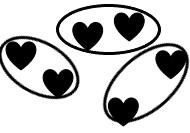
Explanation:
As asked in the question I have paired the set of objects. By observing the objects we could tell that the number of objects is even.
 Even/Not Even
Even/Not Even
Answer:
The number of objects is not even.
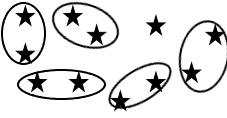
Explanation:
As asked in the question I have paired the set of objects. By observing the objects we could tell that the number of objects is not even.
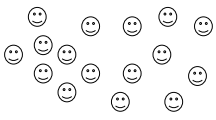 Even/Not Even
Even/Not Even
Answer:
The number of objects is even.

Explanation:
As asked in the question I have paired the set of objects. By observing the objects we could tell that the number of objects is even.
Question 2.
Draw to continue the pattern of the pairs in the space below until you have drawn 10 pairs.

Answer:
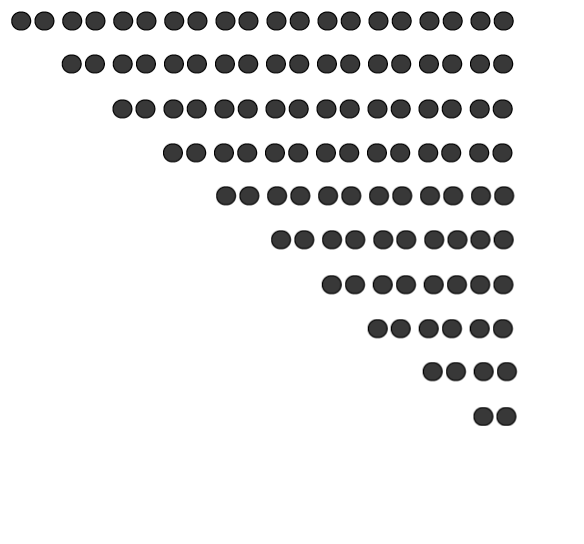
Explanation:
As asked in the question I have drawn the pattern of pairs in the space given above. By observing the pairs we have drawn we could tell that the number of objects is even.
Question 3.
Write the number of dots in each array in Problem 2 in order from least to greatest.
Answer:
2 4 6 8 10 12 14 16 18 20
Explanation:
The number of dots in each array in problem 2 in order from least to greatest is 2 4 6 8 10 12 14 16 18 20
Question 4.
Circle the array in Problem 2 that has 2 columns of 7.
Answer:
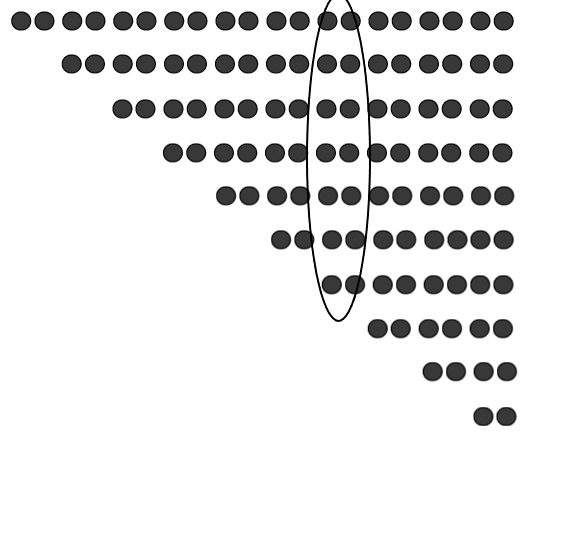
Explanation:
I have circled the array in problem 2 that has 2 columns of 7.
Question 5.
Box the array in Problem 2 that has 2 columns of 9.
Answer:

Explanation:
I have circled the array in problem 2 that has 2 columns of 9.
Question 6.
Redraw the following sets of dots as columns of two or 2 equal rows.
a. 
There are _________ dots.
Is ____ an even number?
Answer:
There are 10 dots. The number 10 is an even number.
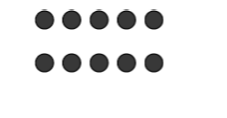
Explanation:
I have redrawn the following sets of dots as columns of two. By counting, there are 10 dots and that number is an even number.
b. 
There are _________ dots.
Is ____ an even number?
Answer:
There are 15 dots. The number 15 is an odd number.
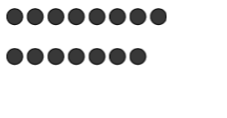
Explanation:
I have redrawn the following sets of dots as columns of two. By counting, there are 15 dots and that number is an odd number.
Question 7.
Circle groups of two. Count by twos to see if the number of objects is even.

a. There are _______ twos. There are ______ left over.
Answer:

Explanation:
I have circled groups of two. And by counting the twos we can identify the number of objects is even.
b. Count by twos to find the total.
_____, _____, _____, _____, _____, ______, _____, _____, ______
Answer:
2, 4, 6, 8, 10, 12, 14, 16, 18
Explanation:
There are 9 twos we have circled as asked in the above question. Hence by counting the number of twos the total is 2, 4, 6, 8, 10, 12, 14, 16, 18
c. This group has an even number of objects: True or False
Answer:
True
Explanation:
The 8 is divisible by 2 as we have 8 two’s circled in the group. Hence this group has an even number of objects.
Eureka Math Grade 2 Module 6 Lesson 18 Exit Ticket Answer Key
Redraw the following sets of dots as columns of two or 2 equal rows.
Question 1.

There are _________ dots.
Is ____ an even number?
Answer:
The 13 is an odd number.
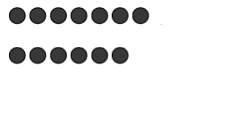
Explanation:
I have redrawn the set of stars as a column of two. In this, we got 13 dots as that 13 is not divisible by 2 we could say that set of stars is an even number.
Question 2.

There are _________ dots.
Is ____ an even number?
Answer:
There are 16 dots and the number 16 is an even number.
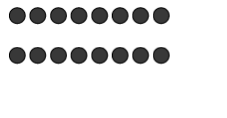
Explanation:
I have redrawn the set of stars as a column of two. In this, we got 16 dots as 16 is divisible by 2 so we could say that set of stars is an even number.
Eureka Math Grade 2 Module 6 Lesson 18 Homework Answer Key
Question 1.
Pair the objects to decide if the number of objects is even.
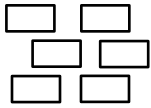 Even/Not Even
Even/Not Even
Answer:
The number of objects here is even.
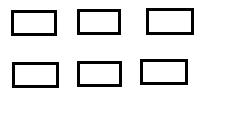
Explanation:
I have redrawn the set of objects as a column of two. In this we got 6 objects as that 12 is divisible by 2 we could say that set of stars is an even number.
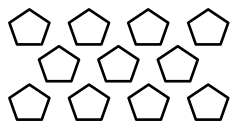 Even/Not Even
Even/Not Even
Answer:
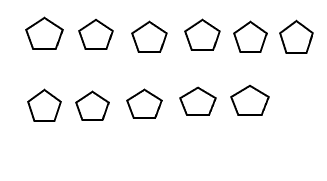
Explanation:
I have redrawn the set of stars as a column of two. In this, we got 11 objects as that 11 is not divisible by 2 we could say that set of stars is an odd number.
 Even/Not Even
Even/Not Even
Answer:
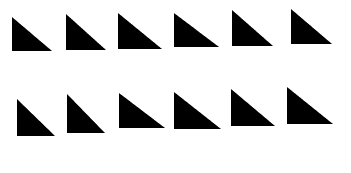
Explanation:
I have redrawn the set of stars as a column of two. In this we got 12 objects as that 12 is divisible by 2 we could say that set of stars is an even number.
Question 2.
Draw to continue the pattern of the pairs in the spaces below until you have drawn zero pairs.

Answer:

Explanation:
I have continued to draw the pattern of pairs in the spaces above until we got zero pairs.
Question 3.
Write the number of hearts in each array in Problem 2 in order from greatest to least.
Answer:
18, 16, 14, 12, 10, 8, 6, 4, 2
Question 4.
Circle the array in Problem 2 that has 2 columns of 6.
Answer:

Explanation:
I have circled the array in problem 2 that has 2 columns of 6.
Question 5.
Box the array in Problem 2 that has 2 columns of 8.
Answer:

Explanation:
I have circled the array in problem 2 that has 2 columns of 8.
Question 6.
Redraw the set of stars as columns of two or 2 equal rows.

There are _________ stars.
Is ____ an even number?
Answer:
There are 12 stars.
And 12 is an even number.

Explanation:
I have redrawn the set of stars as a column of two. In this we got 12 stars as that 12 is divisible by 2 we could say that set of stars is an even number.
Question 7.
Circle groups of two. Count by twos to see if the number of objects is even.

a. There are _______ twos. There are ______ left over.
Answer:
There are 8 twos. There are none left over.

Explanation:
By counting the given group we had known there are 8 twos and there are none left over. Hence the number of objects is even as 8 twos is divisible by 2.
b. Count by twos to find the total.
_____, _____, _____, _____, _____, ______, _____, _____
Answer:
2, 4, 6, 8, 10, 12, 14, 16
Explanation:
There are 8 twos we have circled as asked in the above question. Hence by counting the number of twos the total is 2, 4, 6, 8, 10, 12, 14, 16
c. This group has an even number of objects: True or False.
Answer:
True.
Explanation:
The 8 is divisible by 2 as we have 8 two’s circled in the group. Hence this group has an even number of objects.